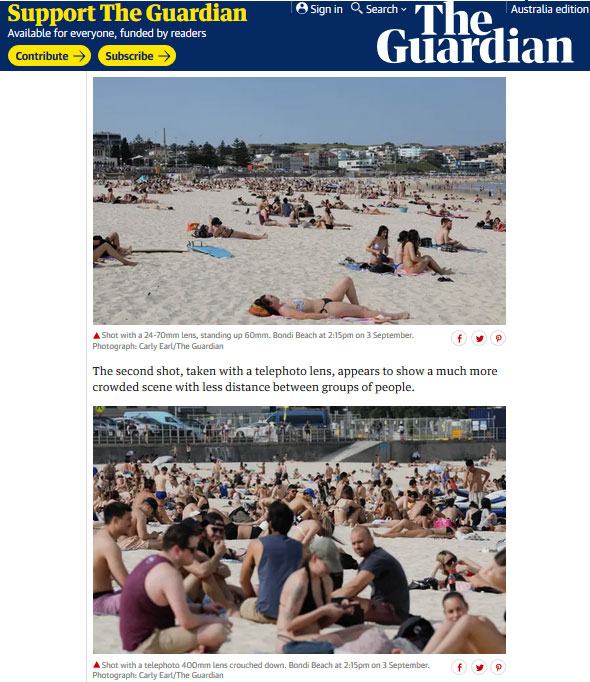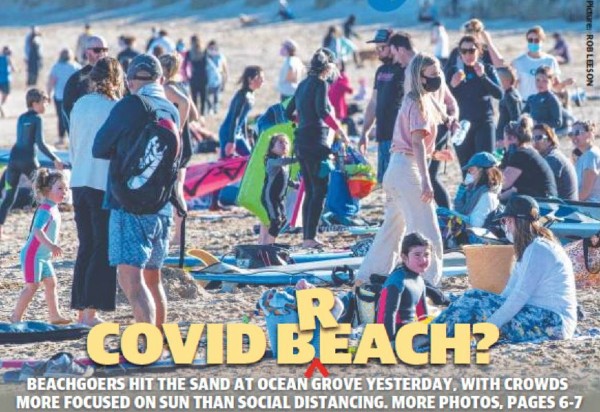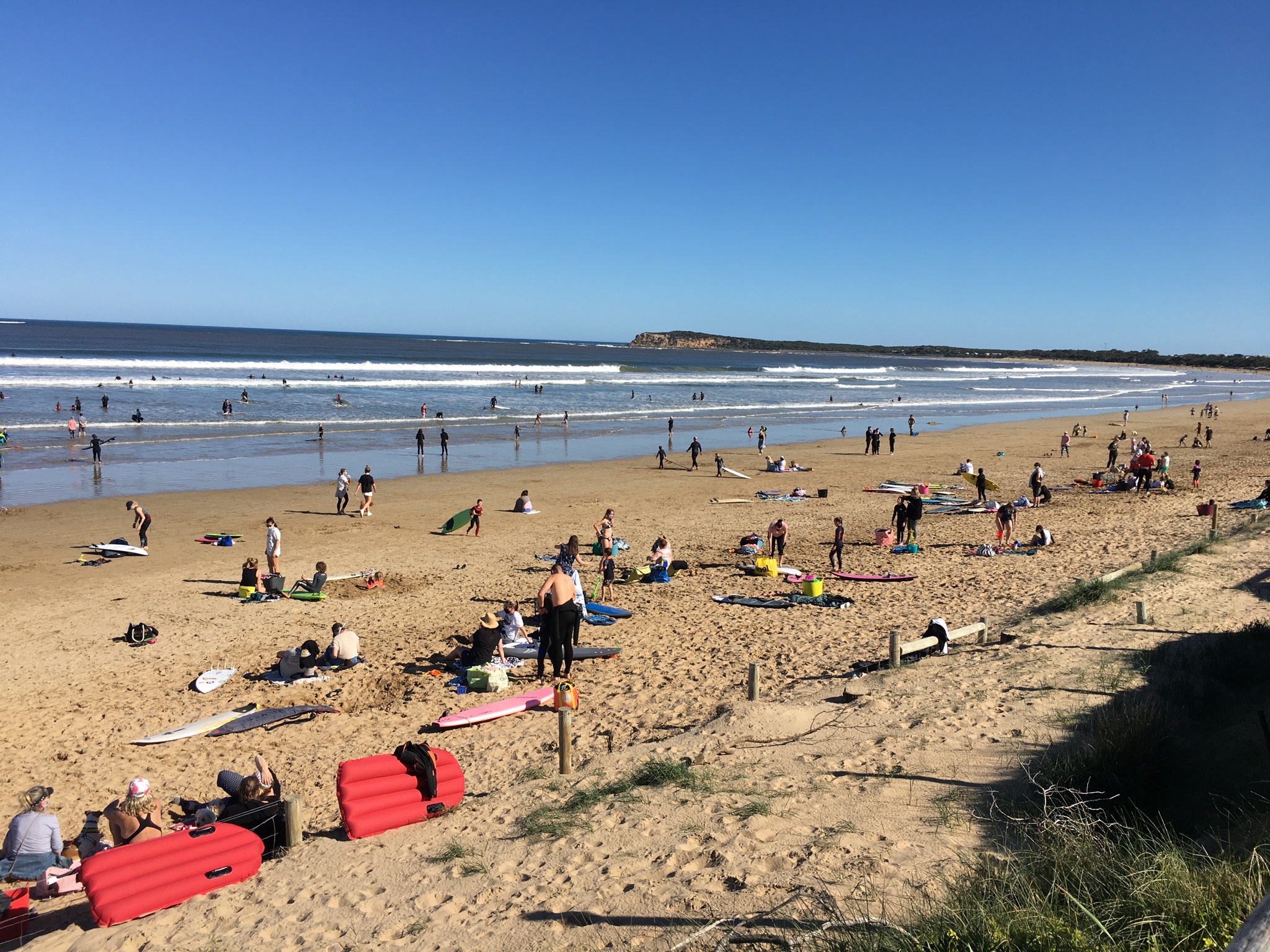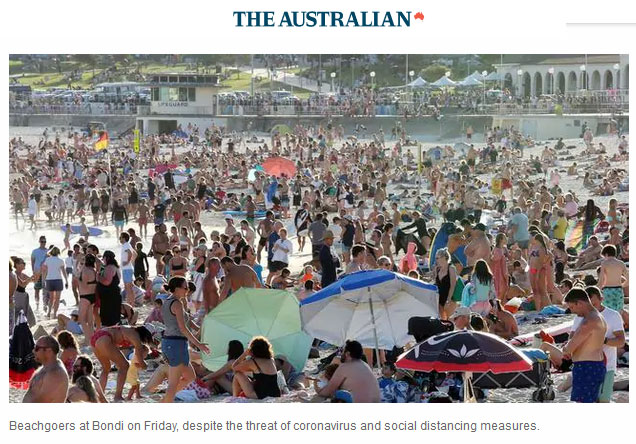News photos captured with a telephoto lens showing overcrowded beaches during Covid restrictions have been accused of being misleading, as lens compression distorts the distance between subjects.

Press photographers and photojournalists are expected to follow a strict code of ethics to ensure the scenes they capture is as close to representing reality as possible. While many photojournalists argue it’s impossible to capture ‘absolute truth’ and be completely objective, it’s still considered imperative to strive for balance.
This is why image manipulation through excessive post-processing, such as cloning out elements, is considered a cardinal sin by photojournalists, news agencies, and journalism institutions. But not all rules are clear and there are grey areas. Photojournalists choose the gear, settings, composition, and how to edit the photo, and these decisions can easily misrepresent reality.
As ‘social distancing’ became a legal requirement to curb the spread of Coronavirus, media outlets have jumped at the opportunity to publish pictures of the public flouting this new rule.
On August 30, the Sunday Herald Sun published a photo showing large crowds gathered at the beach in Ocean Grove, Victoria, during the Stage 3 Lockdown which prohibits leaving the house for anything other than shopping or exercise.
The photo was captured with a telephoto lens by press photographer Rob Leeson, who has 40 years experience working with major international and local news outlets. Leeson hasn’t responded to our request for comment.
Writer and photographer, Sarah Walker, happened to be on the beach when Leeson captured the image. This is what she had to say about the incident on Twitter:
‘I saw the photographer who shot these images. Hard to miss a man carrying a monopod and a lens the size of a toddler. The greater the zoom on a lens, the more it compresses the space. Old mate’s lens went to at least 400mm. Practically, that means the lens natively compresses the distance between objects. By shooting down the beach, it makes the people look very, very close together.
Ocean Grove was packed yesterday. But for the most part, people were doing a very impressive job of keeping socially distanced. The police were there keeping an eye on things.
This is what the beach actually looked like at the exact time that press photographer was taking those images. Busy, but not nearly so frightening. Shots like the one in the Herald Sun don’t happen by accident. Nobody goes out shooting with a lens that big unless their photo editor has specifically asked for a shot designed to rile people up. People say the camera doesn’t lie. It’s not true.’

Back in March, when Covid and social distancing were fresh, photos also emerged of Bondi Beach in Sydney with an ‘unacceptable’ number of people enjoying the warm start of Autumn. While numerous photos with different focal lengths were circulated showing an alarming number of people at Bondi, tabloid media published photos captured with a telephoto lens. The Waverley Council’s decision to close numerous Sydney beaches was likely influenced by the articles and photos.

More photos have since emerged of crowded Bondi, but the Council has become more wary of misleading images.
‘There have been some photos in some publications that have shown people weren’t social distancing, but when we checked, they were. So it’s just a matter of the angle of the photo that was taken,’ Paula Masselos, the mayor of Waverley Council, recently said to The Guardian. ‘I’m hoping that the photographs that are taken will accurately represent the reality on the ground.’
In May a crowded Californian beach photo shot with a 380mm focal length went viral, and also contributed to temporary beach closures. The OC Register, which published the photo, was accused of ‘journalistic impropriety’ and defended the photo by stating the long lens was used to ‘get as much of the beach… to accurately depict the scene.
The Guardian photographer, Mike Bowers, suggests aerial drone photos are more accurate at representing a crowded space.





Thank you for pointing this out. In the US, these long lens beach photos have frequently been used to manipulate perceptions about beach usage during covid.
Who takes responsibility for what is published? Is it the reporter, the photographer or the Editor?
I have known photographer Rob Leeson since I was a cadet photographer, worked alongside him, been his boss as a former Picture Editor of the Sunday Herald Sun. Leeson’s image of the crowded beach scene is an image constructed to fit the narrative and the editorial leaning of the Sunday Herald Sun. Pointing blame at the photographer, who has worked for both News Ltd and Fairfax in his distinguished career as a photojournalist, when in fact the finger should be pointed at the Editor, who has the final say over both the words and pictures that are submitted for publication. I haven’t seen the More Photos,
P 6-7 as I no longer subscribe to any News Ltd publications. I would be interested to know what camera lens combination Sarah Walker used as a wide angle lens would push the subjects further away. Or should all photojournalist capture solely with a 50mm lens.
Cameras don’t lie, photographers do. And picture editors.
Sorry no offence meant to you Darren!
I would not shoot for a dishonest bad journalism news outlet in the first place. It is the responsibility of the photojournalist to choose who they shoot for. No excuses. When you press the shutter button, you take the responsibility for the shot.
As Life photographer W. Eugene Smith once said, “The journalistic photographer can have no other than a personal approach; and it is impossible for him to be completely objective. Honest yes; objective no.”
What i do not understood is in truth how you are not actually a lot more smartly-liked than you may be now. You are very intelligent. You realize therefore significantly in the case of this topic, produced me individually imagine it from numerous numerous angles. Its like men and women don’t seem to be fascinated until it is one thing to do with Woman gaga! Your own stuffs nice. All the time care for it up!
Your reflection is excellent absolutely golden.